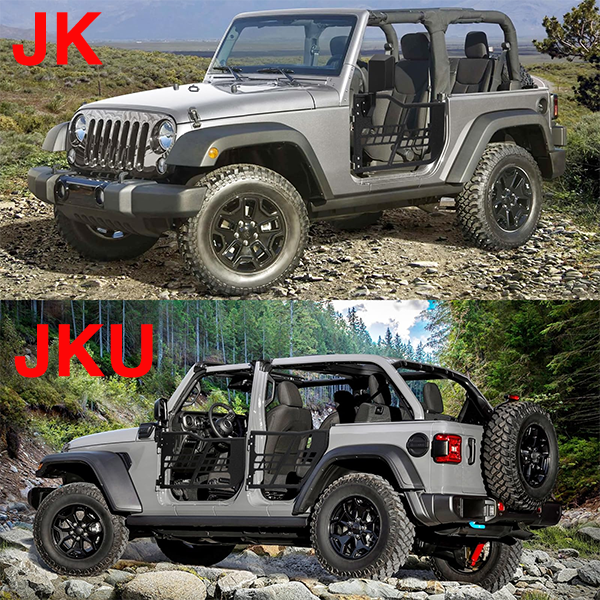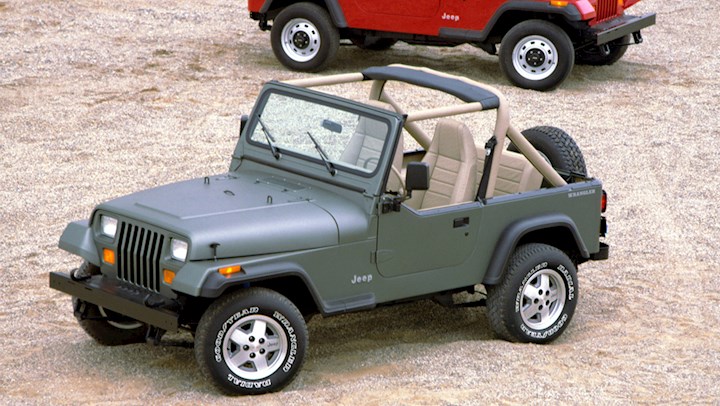This post contains affiliate links. If you click on a link and make a purchase, we may earn a commission at no additional cost to you.
The Jeep Wrangler, an enduring symbol of rugged exploration, has evolved through various models over the years, each contributing to the rich legacy of off-road adventure. In this extensive blog post, we’ll embark on a journey through the history of Jeep Wrangler models, with a particular focus on the Jeep Wrangler JK and its extended counterpart, the JKU. From the iconic Jeep CJ series to the latest innovations, we’ll unravel the unique characteristics that define each model and delve into the distinctions between the Wrangler JK and JKU.

The Evolution of Jeep Wrangler Models:
1. Jeep CJ Series:
- The Jeep CJ (Civilian Jeep) series laid the foundation for the Wrangler’s off-road prowess. Introduced in the 1940s, these military-inspired vehicles were the precursor to the modern Jeep Wrangler. With open-air driving and robust design, the CJ series set the stage for the Jeep’s enduring legacy.
2. Jeep Wrangler YJ: A New Era (1987-1995):
- The YJ model marked a significant departure from the CJ series, introducing square headlights and a revised suspension system. Despite initial skepticism, the YJ gained popularity and paved the way for the evolution of the Wrangler.

3. Jeep Wrangler TJ: A Return to Roots (1997-2006):
- The TJ brought back round headlights, paying homage to the classic Jeep design. Its coil-spring suspension and updated interior contributed to a more comfortable ride. The TJ was a bridge between tradition and modernity.
4. Jeep Wrangler JK: A Bold Leap (2007-2018):
- The Wrangler JK represented a leap forward in design and functionality. With a more prominent grille, available four doors, and improved interior features, the JK became a symbol of the modern Jeep. Its success set the stage for further innovation.
Nilight Front Bumper Compatible for 2007 2008 2009 2010 2011 2012 2013 2014 2015 2016 2017 2018 Jeep Wrangler JK/JKU Rock Crawler Winch Plate
Rear Bumper Compatible with 2007-2018 Jeep Wrangler JK & Unlimited Rock Crawler Bumper w/2" Hitch Receiver, D-Ring, LED Lights (Textured Black)
$179.00 (as of January 17, 2024 05:11 GMT +00:00 - More infoProduct prices and availability are accurate as of the date/time indicated and are subject to change. Any price and availability information displayed on [relevant Amazon Site(s), as applicable] at the time of purchase will apply to the purchase of this product.)LEDKINGDOMUS Full Width Front Bumper Compatible with 07-18 Jeep Wrangler JK and JK Unlimited Rock Crawler With Fog Lights Hole, Winch Plate Black Textured
Tyger Auto TG-BP6J70078 Tyger Fury Short Stubby Front Bumper w/Winch Plate Compatible with 07-18 Jeep Wrangler JK; 2018-2024 Wrangler JL (Include 21-24 4xe); 2020-2024 Gladiator | Textured Black
$265.00 (as of January 17, 2024 05:11 GMT +00:00 - More infoProduct prices and availability are accurate as of the date/time indicated and are subject to change. Any price and availability information displayed on [relevant Amazon Site(s), as applicable] at the time of purchase will apply to the purchase of this product.)Rubber Hood Stop Support Bonnet Bumper Cushion for Jeep Wrangler JK 2007-2017 ,2 Pack
ECOTRIC Front Bumper Compatible with 2007-2022 Jeep Wrangler JK/JKU JL/JLU Gladiator JT With Winch Plate, LED Lights and D-rings
$195.00 (as of January 17, 2024 05:11 GMT +00:00 - More infoProduct prices and availability are accurate as of the date/time indicated and are subject to change. Any price and availability information displayed on [relevant Amazon Site(s), as applicable] at the time of purchase will apply to the purchase of this product.)5. Jeep Wrangler JL: The Next Chapter (2018-Present):
- The Wrangler JL maintained the Wrangler’s iconic design while incorporating modern elements. Improved aerodynamics, a refined interior, and advanced technology showcased Jeep’s commitment to keeping the Wrangler relevant and capable.
Jeep Wrangler JK and JKU: Understanding the Difference:
1. Jeep Wrangler JK:
- The Jeep Wrangler JK, produced from 2007 to 2018, represented a significant departure from its predecessor, the TJ. Key features of the JK include:
- Design Evolution: The JK featured a more prominent and upright grille, providing a bold and modern appearance.
- Four-Door Option: The JK introduced the four-door Unlimited (JKU) model alongside the traditional two-door variant. This marked a shift towards enhanced passenger capacity and increased interior space.
- Improved Interior: The JK’s interior received upgrades in terms of materials, technology, and overall comfort. Modern features like touchscreen infotainment systems and improved sound insulation were introduced.
Rough Country Front Neoprene Seat Covers for 13-18 Jeep JK | 4-Door - 91004F , Black
$119.95 (as of January 16, 2024 05:27 GMT +00:00 - More infoProduct prices and availability are accurate as of the date/time indicated and are subject to change. Any price and availability information displayed on [relevant Amazon Site(s), as applicable] at the time of purchase will apply to the purchase of this product.)OASIS AUTO Jeep Wrangler JK JL Accessories Seat Covers 2007-2025 Custom Fit 2/4 Door Leather Cover Protector Cushion Unlimited X Rubicon Sahara and More (Front Bucket Pair, Black)
$109.99 (as of January 16, 2024 05:27 GMT +00:00 - More infoProduct prices and availability are accurate as of the date/time indicated and are subject to change. Any price and availability information displayed on [relevant Amazon Site(s), as applicable] at the time of purchase will apply to the purchase of this product.)Coverado Jeep Wrangler Seat Covers 4-Door Fullset, Waterproof Car Seat Covers for Truck Automotive Seat Covers Custom Fit for 2007-2023 Jeep Wrangler JK JL(Black)
Huidasource Wrangler JK Seat Cover 4 Door, Leather Custom Car Seat Covers, Front&Rear Seat Cushion Protector Fit for Jeep Wrangler JK 4-Door Sahara Sport Rubicon 2007-2017(Full Set/Black&Red)
Rough Country Neoprene Seat Covers for 2013-2018 Jeep Wrangler | 4-Door - 91004
$199.95 (as of January 16, 2024 05:27 GMT +00:00 - More infoProduct prices and availability are accurate as of the date/time indicated and are subject to change. Any price and availability information displayed on [relevant Amazon Site(s), as applicable] at the time of purchase will apply to the purchase of this product.)BLINGBEAR Faux Leather Custom Car Seat Covers Fit for 07-22 Jeep Wrangler JK/JL 2/4 Doors 4XE Sahara Unlimited Sport Snuggly Gladiator ((4 Door) 07-22 Full Set, Wine Red)
$199.00 (as of January 16, 2024 05:27 GMT +00:00 - More infoProduct prices and availability are accurate as of the date/time indicated and are subject to change. Any price and availability information displayed on [relevant Amazon Site(s), as applicable] at the time of purchase will apply to the purchase of this product.)2. Jeep Wrangler JKU (Unlimited):
- The JKU, often referred to as the Jeep Wrangler Unlimited, is an extended version of the JK model, offering additional space and versatility. Key characteristics of the JKU include:
- Extended Wheelbase: The JKU features a longer wheelbase than the standard JK, providing more rear-seat space and increased cargo capacity.
- Four Full Doors: Unlike the standard JK, the JKU comes exclusively with four full-size doors, making it more convenient for rear passengers to enter and exit the vehicle.
- Family-Friendly: With its increased interior space, the JKU is often considered a more family-friendly option, accommodating more passengers comfortably.
Comparing Performance and Off-Road Capabilities:
1. Off-Road Prowess:
- Both the Jeep Wrangler JK and JKU share the renowned off-road capabilities inherent to the Wrangler lineage. Their robust 4×4 systems, solid front and rear axles, and impressive ground clearance make them formidable off-road companions.
2. Maneuverability:
- The standard JK, with its shorter wheelbase, tends to have slightly better maneuverability in tight spaces compared to the longer JKU. This can be advantageous in challenging off-road scenarios that demand quick turns and precise control.
3. Interior Space:
- The primary distinction between the JK and JKU lies in interior space. The JKU, with its extended wheelbase, offers more rear-seat legroom and increased cargo capacity. This makes the JKU a preferred choice for those who prioritize passenger comfort and storage.
Understanding the Enthusiast’s Perspective:
1. Two-Door JK:
- Enthusiasts who favor the two-door JK appreciate its classic and compact design. It retains the essence of the traditional Jeep, providing a nimble and agile driving experience. The shorter wheelbase enhances maneuverability, making it ideal for tight trails and rocky terrain.
2. Four-Door JKU:
- Those drawn to the four-door JKU often prioritize practicality and versatility. The additional interior space accommodates families or groups of friends, and the rear doors provide easier access to the rear seats. The JKU’s longer wheelbase contributes to a smoother on-road ride.
Ownership Considerations:
1. Everyday Commute:
- The two-door JK is well-suited for urban commuting due to its compact size and agility. The four-door JKU, while still manageable, may require additional considerations for parking and maneuvering in tight city spaces.
2. Adventure and Exploration:
- For off-road enthusiasts seeking adventure, both the JK and JKU are capable companions. The choice between the two often boils down to personal preferences, with some favoring the agility of the two-door for challenging trails and others appreciating the spaciousness of the four-door for extended trips.
3. Family-Friendly Features:
- Families or individuals requiring more space for passengers and gear may find the JKU better suited to their needs. The four-door configuration, combined with ample cargo space, makes it an attractive option for those with an active lifestyle.
Customization and Modifications:
1. JK and JKU Aftermarket Support:
- Both the JK and JKU benefit from a robust aftermarket support system. Enthusiasts can customize their vehicles with a wide array of accessories, from lift kits and bumpers to lighting upgrades and specialized off-road equipment.
2. Personalization Options:
- The ability to personalize a Jeep Wrangler is a significant draw for enthusiasts. Whether it’s installing a rooftop tent for camping adventures or enhancing off-road capabilities with upgraded suspension, both the JK and JKU offer a canvas for self-expression.
Making the Choice
In the world of Jeep Wranglers, the decision between the JK and JKU ultimately comes down to individual preferences, lifestyle, and the intended use of the vehicle. Whether you are drawn to the classic appeal of the two-door JK or the practicality of the four-door JKU, both models embody the spirit of adventure and off-road capability that defines the Jeep brand.
As the Wrangler lineage continues to evolve with each new generation, one thing remains constant – the unwav
This post contains affiliate links. If you click on a link and make a purchase, we may earn a commission at no additional cost to you.














![RockTrix Wheels compatible with Jeep 2007-2023 Wrangler JK JL and 2019-2023 Gladiator JT. NOTE: Wheels will extend past fenders. [SPECIFICATIONS] 5x5" (5x127) Bolt Pattern. 17x9 Wheel Size. -12 Offset (4.5" Backspacing). 71.5mm Centerbore. Features a...](https://m.media-amazon.com/images/I/51eMqIvIhJL._SL300_.jpg)

![RockTrix Wheels compatible with Jeep 2007-2023 Wrangler JK JL and 2019-2023 Gladiator JT. NOTE: Wheels will extend past fenders. [SPECIFICATIONS] 5x5" (5x127) Bolt Pattern. 17x9 Wheel Size. -12 Offset (4.5" Backspacing). 71.5mm Centerbore. Features a...](https://m.media-amazon.com/images/I/51B9VQcSS2L._SL300_.jpg)
![RockTrix Wheels compatible with Jeep 2007-2023 Wrangler JK JL and 2019-2023 Gladiator JT. NOTE: Wheels will extend past fenders. [SPECIFICATIONS] 5x5" (5x127) Bolt Pattern. 17x9 Wheel Size. -12 Offset (4.5" Backspacing). 71.5mm Centerbore. Features a...](https://m.media-amazon.com/images/I/51jYq+JTwJL._SL300_.jpg)
![RockTrix Wheels compatible with Jeep 2007-2023 Wrangler JK JL and 2019-2023 Gladiator JT. NOTE: Wheels will extend past fenders. [SPECIFICATIONS] 5x5" (5x127) Bolt Pattern. 17x9 Wheel Size. -12 Offset (4.5" Backspacing). 71.5mm Centerbore. Features a...](https://m.media-amazon.com/images/I/51sLElue86L._SL300_.jpg)